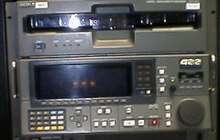D1 SMPTE

Sony DVR-2000 D1 VCR
|
|
| Media type | Magnetic Tape |
|---|---|
| Encoding | NTSC, PAL |
| Read mechanism | Helical scan |
| Write mechanism | Helical scan |
| Standard | Interlaced video |
| Developed by | Sony |
| Usage | Video production |
D-1 or 4:2:2 Component Digital is a SMPTE digital recording video standard, introduced in 1986 through efforts by SMPTE engineering committees. It started as a Sony and Bosch - BTS product and was the first major professional digital video format. SMPTE standardized the format within ITU-R 601 (orig. CCIR-601), also known as Rec. 601, which was derived from SMPTE 125M and EBU 3246-E standards.
D-1 or 4:2:2 D-1 (1986) was a major feat in real time, broadcast quality digital video recording. It stores uncompressed digitized component video, encoded at Y'CbCr 4:2:2 using the CCIR 601 raster format with 8 bits, along with PCM audio tracks as well as timecode on a 3/4 inch (19 mm) videocassette tape (though not to be confused with the ubiquitous 3/4-inch U-Matic/U-Matic SP cassette).
The uncompressed component video used enormous bandwidth, 173 Mbit/sec (bit rate), for its time. The maximum record time on a D-1 tape is 94 minutes.
Because of the uncompromising picture quality - component processing and uncompressed recording, D-1 was most popular in high-end graphic and animation production - where multiple layering had previously been done in short run times via hard drives (Quantel Harry, Henry, Harriet, Hal or Abekas DDR) or via multiple analog machines running at once. Hard drives in the 1980s that stored broadcast-quality video would typically only hold 30 seconds to a few minutes of space, yet the systems that made them work could cost $500,000. By contrast, the D-1 machine allowed 94 minutes of recording on a $200 cassette.
...
Wikipedia
